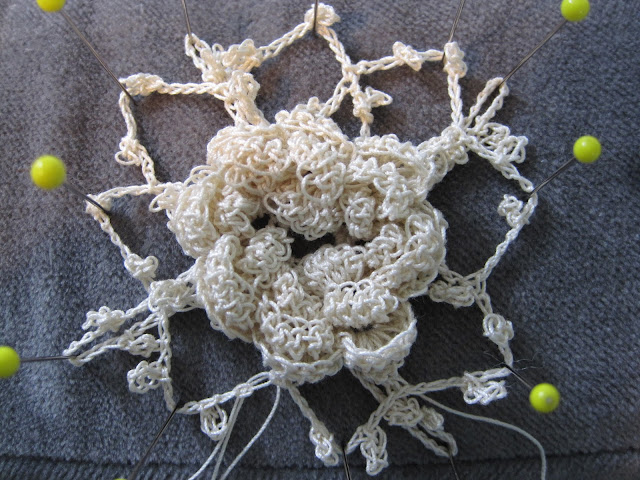I can't tell you how many times I ripped out and reworked them. Here are some pointers and pictures to help you make sense of the instructions.
You may have noticed this is not a tutorial in the traditional sense. I am not working from start to finish assuming you are a crochet newbie. I am counting on a basic understanding of the following stitches: Chain, Slip Stitch, Single Crochet, and Double Crochet. Also, I am not redoing the pattern from start to finish, but trying to provide clarification in areas that proved troublesome for me. See, it's all about me. As usual.
Row 8: The pattern describes a Picot Loop as ch 3, ch 6-picot, ch 3, ch 6-picot, ch 3. This is what it looks like (upside down).
Get comfortable with this as you will be making a LOT of them!
A variation of this is what I am going to call the Corner Loop. The instructions are ch 7, ch 6-picot, ch 7, ch 6-picot, ch 7. You will only make 4 of them and only in Row 8.
Much of Row 8 is worked from the back side of the piece in a manner similiar to when you made the Rose in Part 1.
To begin you make a Picot Loop, ending in the next petal. You can see I have begun, but not attached the Corner Loop (next step).
The second step is to make a Corner Loop. This ends in the same petal where you started the loop. Please refer to the illustration. and photo below.
Next is another Picot loop.
You make this series of Loops 3 more times to finish the round (Picot Loop, Corner Loop, Picot Loop, repeat).
Here's what it looks like when you are finished with Row 8.
I found it very helpful to pin this out from time to time. You should have 4 Corner Loops and 8 Picot Loops. Double check, because it is much easier to correct it now than later.
Don't panic if your project looks like this. Mine did too before I pinned it. Nice, huh? This may have been part of the reason I lost my way on this pattern.
Row 9: This is where I ran into the first bit of trouble. The instructions are silent on what to do with the Corner Loops. Here's the best advice I can give you. Put stitch markers on them (to make them easier to identify them in Row 10 and you do nothing with the Corner Loops in Row 9. The stitch markers also make it easier to ignore them in this row.
Stitch markers? Holy cow, those weren't on the list of supplies! Don't worry. Alice, from future girl uses those cute colored paperclips. Clever, clever girl. Even regular paper clips will do and most folks have a few sliding around in the junk draw in the kitchen.
I scratched out a quick diagram showing how this row should be worked. I just worked infront of the Corner Loops - the stitch marker should hold them out of your way.
Row 9 is in green. You will be attaching 8 picot loops to the 8 picot loops in Row 8 - ignoring the corners. It's important to note that you worked Row 8 from the back of the center rose. For this point onward, you will be working from the front with the center rose facing you.
To begin the instructions say to slip stitch into the middle of a Row 8 picot loop. From there you begin to work Row 9. I hope this little diagram helps The slip stiches are in green.
Row 10: For this row you will attach the Corner Loops. You will finish with a total of 12 new picot loops in this row, because you included the corner loops as you work your way around (4+8=12). I have numbered the loops in the photo below. The corners are between loops 1 and 12, 3 and 4, 6 and 7, 9 and 10. Remove the stitch markers as you incorporate each corner.
Row 11: Work picot loops all around. Easy peasy. No funny stuff. Double check to make certain you have 12 picot loops. If it looks like the photo below, finish off with a slip stitch.
Whoo Hoo! You're finished with the network! For me, this was the most difficult section to get my head around. I'm generally pretty good at reading Crochet instructions, but sometimes a few pictures can really help.
Please send a comment if the illustrations or photos were confusing. I will be happy to update the tutorial.
Next tutorial, will be how to make the Leaves.













No comments:
Post a Comment